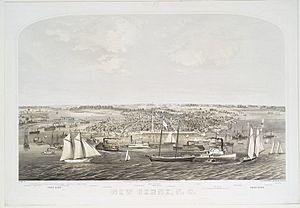Battle of New Bern (1864) facts for kids
Quick facts for kids Battle of New Bern |
|||||||
|---|---|---|---|---|---|---|---|
| Part of the American Civil War | |||||||
 New Bern in 1864 |
|||||||
|
|||||||
| Belligerents | |||||||
| Commanders and leaders | |||||||
| Innis N. Palmer | George E. Pickett | ||||||
| Units involved | |||||||
| New Bern Garrison | Pickett's Division and Hoke’s Brigade |
||||||
| Casualties and losses | |||||||
| 13 killed 26 wounded 364 captured and missing |
200-300 | ||||||
The Battle of New Bern was a fight during the American Civil War. It happened from February 1 to 3, 1864. This battle was about Confederate forces trying to take back the town of New Bern. The Union Army had captured New Bern in 1862. The Confederates did not succeed in taking it back.
Why This Battle Happened
Union soldiers had taken control of New Bern in March 1862. This happened during Burnside's North Carolina Expedition. The town had been under Union control ever since.
In 1864, the Union forces in New Bern were led by Brigadier General Innis N. Palmer. The Confederate ground forces were commanded by Major General George E. Pickett. He worked with Confederate Marines and sailors led by Commander John T. Wood. General Pickett planned a three-part attack on the town.
The Battle Begins
On February 1, Brigadier General Robert F. Hoke's Confederate brigade started the fight. They met a Union outpost near Bachelor's Creek. Colonel Peter Claassen of the 132nd New York Infantry was in charge of this outpost.
Both sides brought out their cannons as the fighting grew. Colonel Claassen told his men to go back into New Bern. Some Union soldiers who were coming to help got lost in the dark and fog. They were captured by the Confederates. Hoke then stopped his brigade outside New Bern. He waited to hear from the other Confederate attacks.
The second Confederate attack was led by Brigadier General Seth Barton. His troops moved across the Trent River. They faced the 17th Massachusetts Infantry. This Union group was led by Colonel Thomas I. C. Amory. They had help from the 3rd New York Light Artillery. Amory's cannons fired at Barton's men. This made Barton think the Union defenses were too strong. So, he pulled his troops back.
Pickett's third attack was led by Colonel James Dearing. His target was Fort Anderson across the Neuse River. When Dearing saw the fort, he also thought the defenses were too strong to attack. By nightfall, General Palmer's Union defenses were still holding strong. Pickett gave up hope of attacking again.
On February 2, Commander Wood and his naval group surprised the crew of the USS Underwriter. This ship was anchored in the Neuse River. Most of the Underwriter's crew got away. But Wood's Confederates took the ship. They planned to sail it downriver and attack the Union Navy Yard.
However, Union cannons from Fort Stevenson began firing at the Underwriter. The ship caught fire. This forced the Confederates who had just captured it to leave. On February 4, General Pickett decided to call off the whole attack. He ordered his troops to retreat.
What Happened Next
After the battle, General Braxton Bragg was an advisor to Jefferson Davis. He suggested that the Confederate leadership should change. General Hoke then took over command of the Confederate efforts. He would later have more success in his attack on Plymouth, North Carolina.

